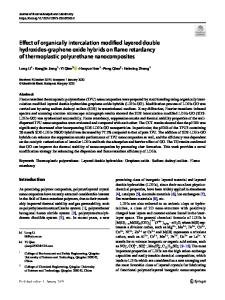NiMoCo layered double hydroxides for electrocatalyst and supercapacitor electrode
- PDF / 14,944,422 Bytes
- 11 Pages / 595.276 x 793.701 pts Page_size
- 35 Downloads / 371 Views
Published online 11 September 2020 | https://doi.org/10.1007/s40843-020-1442-3
NiMoCo layered double hydroxides for electrocatalyst and supercapacitor electrode 1
1
1
1
1*
2*
Hengqi Liu , Depeng Zhao , Ying Liu , Yongli Tong , Xiang Wu and Guozhen Shen ABSTRACT Non-noble-metal electrode materials with high durability and efficiency have become the frontiers of energy conversion and storage fields. However, conventional electrode materials often show high overpotential and low conductivity. To solve this problem, we fabricate a NiMoxCo2−x layered double hydroxide (LDH)/Ni foam (NF) product through a facile hydrothermal route. The as-prepared NiMoCo-LDH/NF catalyst possesses an overpotential of 123 mV for −2 hydrogen evolution reaction (HER) at 10 mA cm and −2 279 mV for oxygen evolution reaction (OER) at 20 mA cm . The as-obtained product exhibits excellent overall water splitting performances. Meanwhile, as the electrode material for supercapacitor, it delivers high specific capacitance and excellent cyclic performance. The asymmetric supercapacitor assembled with NiMoCo-LDH/NF//active carbon exhibits 93% of its initial capacity after 8000 cycles. Keywords: layered double hydroxide, hydrogen evolution reaction, oxygen evolution reaction, overall water splitting, supercapacitor, energy density
INTRODUCTION With the rapid development of human society, the demands for energy resources have become very imperious [1–3]. Currently, most of energy comes from traditional fossil fuels [4–6]. However, they might cause serious environmental pollution, and thus it is urgent to seek for alternative clean energy sources to solve the problem. Hydrogen is widely used owing to its unique superiority such as zero carbon emission, abundant reservation and high efficiency [7–9]. Electrochemical water splitting has been identified as one of the most prosperous hydrogen production technologies [10,11]. However, their two reactions exhibit sluggish kinetic processes and high overpotentials [12–14]. It is still a challenge for rational design of catalysts to accelerate their half reaction rates. Gen1 2
*
erally speaking, noble metal-based catalysts show fast reaction kinetics. Nevertheless, high cost and scarcity limit their widespread applications [15–17]. Recently, many transition metal hydroxides have been widely investigated as electrochemical catalysts [18,19]. Among them, layered double hydroxides (LDHs) stand out due to their adjustable composition, low cost and high activity [20–22]. Thus far, several high-performance LDH structures have been reported, such as NiFe-LDH arrays, NiCo-LDH and ZnCo-LDH electrocatalysts [23– 25]. However, for overall water splitting, they behave with low specific surface area and poor conductivity. These problems can be effectively solved by the reasonable selection and design of electrode materials. For example, Yao et al. [26] synthesized Ni/Co/Fe phosphosulfide nanorods through a hydrothermal electrodeposition route. The as-obtained products possess an overpotential of 195 mV (oxygen evolu
Data Loading...











